Japanese kitchen knives are known worldwide for their incredible beauty, increased strength, amazing sharpness and maximum ease of use. Masters in the production of quality knives, which in their sharpness will not be inferior to the traditional samurai swords, make almost 900 types of various kitchen appliances and accessories these days. For this reason, before choosing the most suitable kitchen knife, you should familiarize yourself with all its features and functionality.
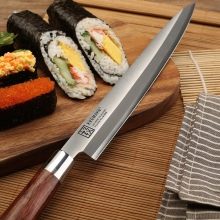


Features
The most obvious sign of a modern Japanese cutting tool can be considered its sharpening on only one side, which allows you to very quickly cut almost transparent pieces of fish or other products that can be part of traditional oriental dishes.
To control a knife with such a unique sharpening, some skill is needed. Therefore, for beginners, difficulties may first arise when using this tool. Accustomed to using conventional models with double-sided sharpening, it can be difficult for an ordinary chef to adapt to working with such unusual products. This is precisely the skill of Japanese professionals.
By the way, today you can easily order and purchase Japanese kitchen products for left-handed people separately, since when purchasing kitchen knives you will often be offered specimens with a blade, which is sharpened only on the right.
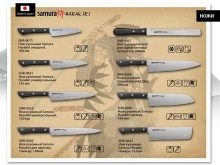


The best blades are those that are made by hand, experienced craftsmen forge themselves, and then polish and sharpen the knife. Very often, on such types of models released in Japan itself, you can see on the hilt a personal signature of a gunsmith.
The main difference between these unique tools can be considered the use of the most durable metal without various components toxic to human health. For their manufacture, the purest types of steel are selected:
- steel "shirogi", better known under the name "snow-white paper";
- steel "aogami", which is popularly called "blue paper";
- Damascus steel.
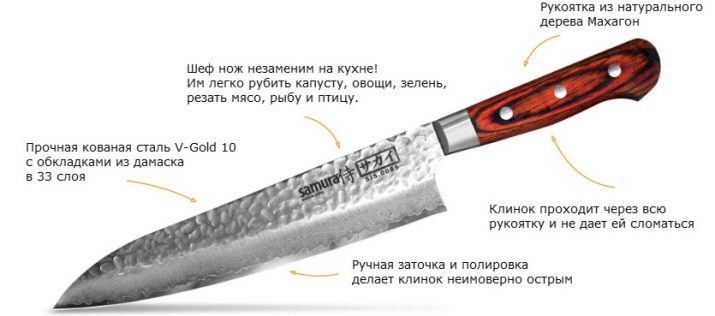
Aogami is a derivative of broads, which differs from the latter by the presence of the smallest particles of chromium and tungsten in the alloy. This variety is considered much stronger than broads, but it will also be less sharp. The main difference between the Aogs is the long-term “life” of the blade, which will retain its sharpness for a long time.
The sharpness indicator of Japanese knives is called “kirenaga” - this is the designation of the time in which the blade will be in a sharpened state. The type of future slicing and the comfort of the cook who wants to get the best result will directly depend on this condition. In order to use such a knife in everyday life, these indicators will not be significant, but it is impossible for a drying chef to imagine their professional activity without the sharpest product made of aogami material.
Blades are characterized by excellent strength and a typical wave-like pattern on the product itself.

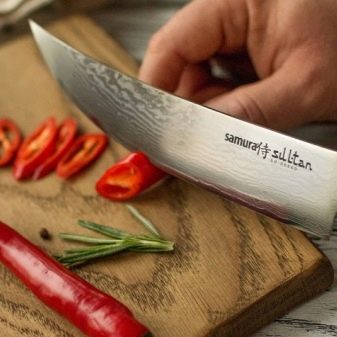
Subtle recesses can be made at the top of the blade - so that when cutting to a knife various products do not stick. Quality kitchen knives made of the most durable steel are made by hand, while the blade is often sharpened and carefully processed. Culinary appliances from Japanese masters have a fairly solid price, which is justified by a long service life. No fancy ceramic, glass or electric knife products can exceed the life of durable knives made in Japan.
The Japanese tried very hard to make the product handle comfortable. To produce this element, expensive materials are selected - micarta and chromed metal. In inexpensive products, you can find handles made of special wood. Most European knives are distinguished by the use of inexpensive polymers, which is why the knives have a short service life due to the frequent breaking of the device in the area of contact between the blade and the plastic handle.


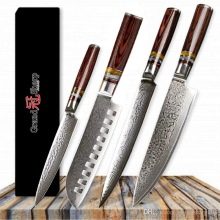
Kinds
There is a fairly wide variety of culinary oriental knives.
- Tojiro knives used both at home and quite popular among professionals. They differ from other products in width, weight, as well as blade length, strength and the number of layers of steel used. For a tool released for domestic use, steel is selected from 1-3 metal layers, and tools for professionals have blades of 30-40 layers of steel.
For the house, it is best to choose the most affordable models - they have wooden handles, and chefs will definitely like copies with integral parts made of steel.

- Usuba Products Suitable for fast cutting vegetables. They are distinguished by a thick butt, the blade has a sharp sharpened blade. On average, the weight reaches 200 g. The severity of the device at the very beginning of operation sometimes causes a feeling of discomfort, but gradually adjusting itself to actively use a cooking tool, you can easily chop solid vegetables.

- Yanagiba Sushi Knife - an important assistant to the chef, with the help of which you can practically "jewelry" cut the fish in the thinnest pieces that will be visible. If you translate the word "yanagiba", it will mean "willow leaf", and in fact the truth bears a complete resemblance to the willow leaf. The blade length of the product is from 25-30 cm. The razor sharpness of the product is suitable for cooking sashimi and will allow you to accurately cut fish into pieces.
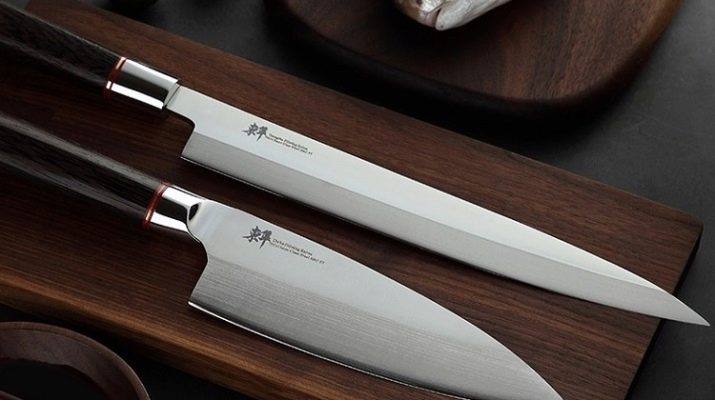
- Deba Models significantly facilitate the work of cooks with complex fish. The rounded shape of the blade has a length of about 16-23 cm and a huge handle for even pressure distribution when cutting the hardest parts of various fish.
This type of product has many varieties - Kunisaki deba helps butcher crabs. A heavy product with a pointed blade is useful for cutting hard shells, they can get meat from lobsters, lobsters or crabs.

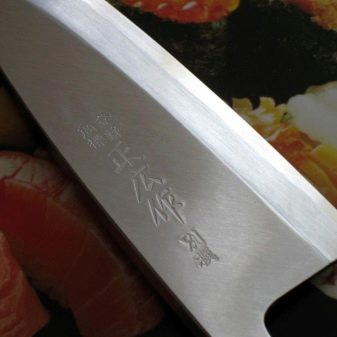
Mioroshi deba is suitable for quick cutting of the thickest fish bones.
- To cut vegetables into smooth, neat slices, we recommend using a Japanese mini hatchet Nakiri. Nakiri is characterized by an extremely thin blade having a thickness of only 2 mm.
- Knife Santoku can be called one of the most versatile oriental knives. If you compare the santoku with European copies, it looks most like a specialized chef-knife. Santoku in translation means "3 virtues", which emphasizes its versatility. Knives are suitable for accelerated cutting of various products, especially if the blades are made of damask steel.
- Gyuto - a thin knife with a length of 18 to 30 cm, they can quickly cut meat and any fish, without doing so much effort.
- Sujihiku - a slicer, was originally necessary in order to draw the veins, these days it is perfectly used for cutting various products.
- Petty Knife (station wagon) - This is a product with multi-purpose functionality, it can be cut and cleaned. It stands out among other tools with a slightly raised handle and blade with a length of 7 to 15 cm.
- Sushikiri - a traditional knife needed to cut a portion of ready-made sushi. It features a rounded blade.
- Nakiri bocho - product for cutting vegetables.
- Pankiri - a special knife in order to cut bread, has a striking wavy sharpening, with its help you can cut even fresh bread without the appearance of crumbs.
- Sashimi yanagiba - it’s good to make sushi or sashimi with this knife. A thin blade will perfectly cut the fillet into the same thin slices. One of its subspecies is considered Fugubiki. This flexible and extremely sharp specimen cuts the famous poisonous puffer fish.
- Sashimi Takobiki - narrow but long items for sashimi. Blades in the form of a rectangle, 20-32 cm long with a sharp end for working with tuna or round, if you want to chop an octopus.
- Unagisaki or Dojosaki - are distinguished by the presence of sharp edges going to the tip and are acquired for cutting eel.
- Baran-kiri - the product in the form of a trapezoid is useful for quick work with crabs.
- Ajikiri - a product with a wide, but with a shortened blade. Such a product is chosen for working with many types of fish. Its length is from 9 to 15 cm, its thickness is up to 4 mm.

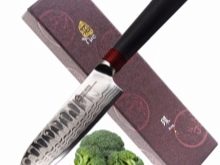

Manufacturers rating
Which companies produce the best Japanese chef knives?
Global
Knives have been produced under the name of this brand for more than 50 years, which are distinguished by the amazing quality of the hardness of the blades. Global launches its products in two versions: the Sai range is for experienced chefs, and the Standard range is for homework. The latter have a textured handle "polka dots" to prevent slipping. The company has a division of products by size - these are large “G” and small “GS”, and the letter “F” informs you that this is a real forged fixture.
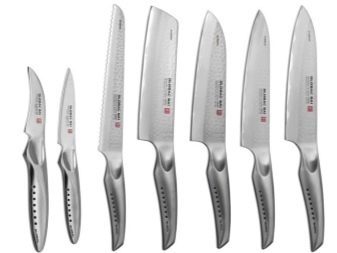
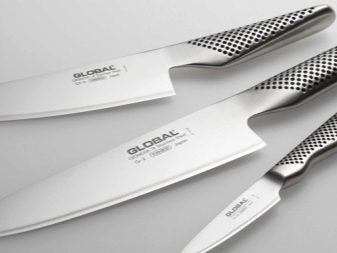
Kanetsugu
Under this brand, the best oriental swords and knives have been produced for many years. Now this dynasty of famous gunsmiths forges blades for culinary purposes, giving them a popular form of katana.
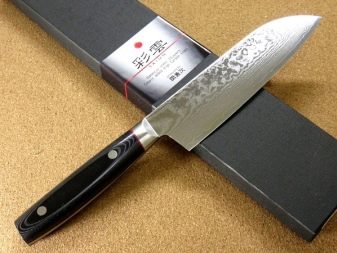
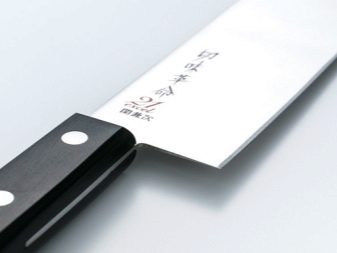
Kasumi
It manufactures products from rather expensive and rare metals, which endow all the series produced with a peculiar “character”.
- A series of Masterprices and a series of Standard. Usually they have an unusual sharpening on both sides and convenient handles made of wood or a fabric base with enlarged weaving, which are fastened with polymers.
- Series "Ceramics". Models that are slightly inferior in strength only to diamond. They have a familiar European sharpening on both sides and a handle made of special plastic, extremely demanding when leaving and must be stored as carefully as possible.
- Hammer Series. Products that have a relief surface, which allows you to create a special pillow from the air between the blade and the products prepared for cutting, which is why nothing sticks to it during processing.
- Series "Titanum". A series of cheap knives with high-quality titanium coating, which guarantees them special strength. It has blades of various colors.

Masahiro
The masters of this brand came up with extremely popular steel from an alloy of molybdenum and vanadium. It was she who glorified oriental knives for the kitchen and brought them world fame. Masahiro products are highly regarded in the restaurant kitchen, and the number of models entering the world market has already exceeded 3 thousand.
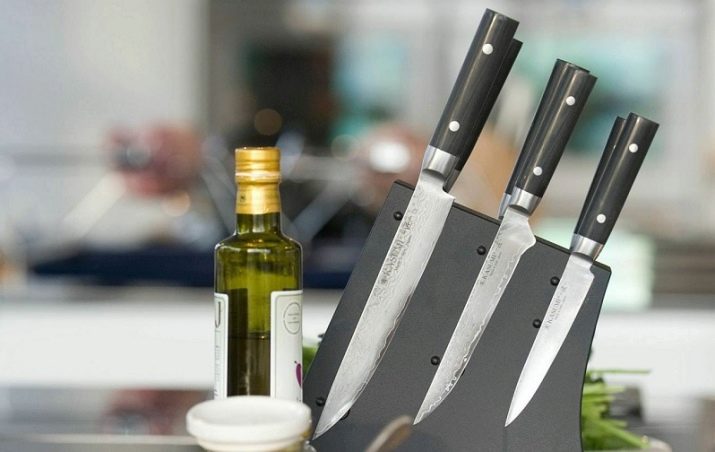
Hattori
It produces both kitchen and hunting knives. Has a high reputation among buyers. Each product is subject to strict control, and if at least one of the parts does not meet the high standards of the brand, it will go to remake. Today, the company produces 3 lines of knives KD, HD and FH.
The highest quality workmanship and consumer characteristics are characterized by the KD series.
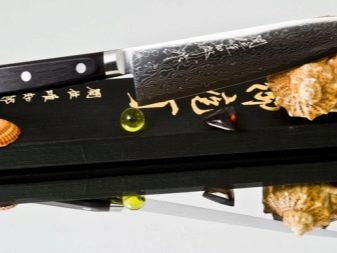
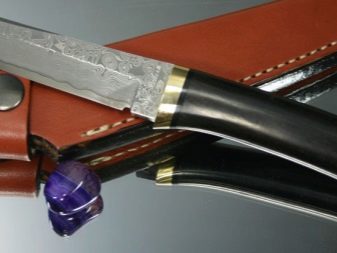
Kiomo
It produces multifunctional universal and durable knives that are resistant to any load. The most common work for a universal product is to peel and cut small-sized products with pleasant ease and grace.
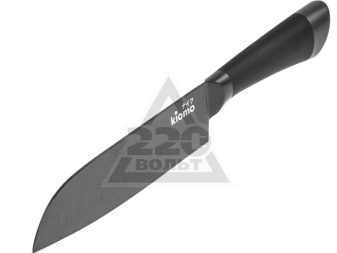

How to choose?
The stunning variety of Japanese knives can sometimes make the final choice difficult. You can correctly select the knives by describing their most detailed characteristics, usually this information is present on the product packaging. You should also be guided by the price, which will classify a particular model as a middle class, standard or premium. The subtype, weight, parameters, the number of layers of steel, the quality of wood or plastic will determine the price of Japanese instruments, which will surpass similar specimens from Europe in many respects.
Particular attention should be paid to sets of knives, which include certain types.
- A universal device will allow you to work with different types of fillets, different fruits, hard vegetables. Convenient for everyday use, fits perfectly in the hand. It features a massive blade. Its main purpose is butchering seafood.
- An excellent chef knife will even cope with large bones and any solid foods from the freezer.
- A vegetable knife is used only to chop vegetables.

Care
The production of knives in Japan is equated with the form of art. For this reason, Japanese craftsmen pay particular attention to the proper operation of their products.
- Never clean this knife in the dishwasher.
- If you store the product together with other devices, this can adversely affect the structure of steel.
- Cutting can be done only on special boards - from polymers, wood or bamboo. Wood can slow down the process of losing sharpness of the blade. The polymer base that will absorb the cut is just perfect for working with a Japanese product.
- The instructions for this product must be strictly followed. Do not use a knife for bread (cheese) when slicing meat and various seafood. These devices can be selected to work with only one type of product. That is why they have a different shape of both the blade and the handle.
- To store such knives is in a special wooden stand, which will absorb moisture. Moisture negatively affects the state of steel. can also be stored on a railing with a magnet, where the likelihood of scratches on the blade will be minimized.
- For greater safety, after applying the knife, it is better to wear a special cover on the sharp blade.
- To maintain the angle of sharpening, it is necessary to sharpen the knives only with a special sharpener.
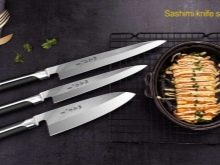
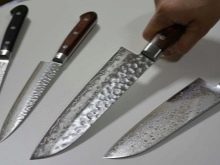
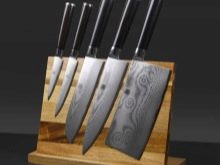
With careful operation and proper care of Japanese blades, they will not lose their amazing sharpness and chic appearance for a long time, while allowing each cook to feel special ease and comfort when working with any solid products.
To learn how to create the famous Japanese kitchen knives Masahiro, see below.










